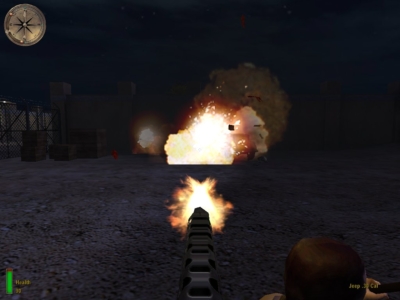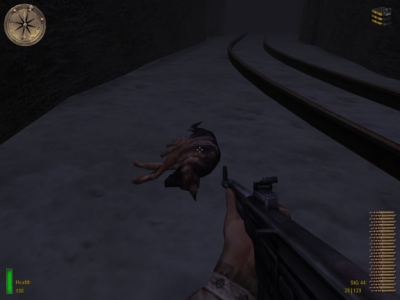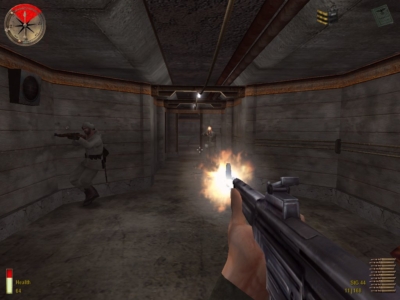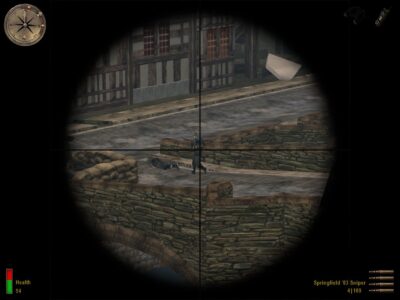
Medal of Honor: Allied Assault
Written by: Rik
Date posted: October 9, 2011
- Genre: Action
- Developed by: 2015
- Published by: Electronic Arts
- Year released: 2002
- Our score: 7
Before there was Modern Warfare, there was Call of Duty. And before Call of Duty, there was Medal of Honor: Allied Assault. Before any of those, though, there was the original Medal of Honor on the Playstation. Despite being afflicted by blurry visuals, small levels, characters with triangular faces and – yes, I’ll say it – joypad controls, it was largely a triumph of atmosphere and playability over the technical limitations of the platform upon which it appeared. Taking on the role of a lone agent deep behind enemy lines, missions generally involved sneaking around while dressed up as a Nazi, pausing occasionally to thrust your stolen identification documents in the faces of your supposed colleagues whenever they asked to see “YOR PAPERZZ” in a comedy German accent, before ultimately blowing your cover and having to shoot your way out.
However enjoyable it was, though, initial talk of porting it over to the PC was greeted by the kind of patronising snootiness that computer owners love to display towards their console counterparts. Back in the time of underpowered consoles that weren’t the natural home for FPS games, though, such an attitude could at least be justified: MoH, on PC, just wouldn’t have passed muster.

We’d never have won the war if it hadn’t been for men blowing shit up using a machine gun mounted on the back of a moving vehicle.
Instead, then, we got Allied Assault, an entirely new game that took the spirit and atmosphere of the original and brought it to PC with all of the sharp graphics and big levels that us arrogant PC types demand. It was a hit with the critics – with some daring to utter the words “Better than Half-Life” without putting those words on the cover of their magazine and adding a question mark to generate some interest in the latest game that obviously wasn’t better than Half-Life but was newer and just happened to be reviewed in that very issue.
Never one to take notice of the latest trends (as even the briefest glance in a mirror reminds me all-too-frequently), I studiously ignored the praise and the game until the recent realisation struck that I really didn’t have a clue what Call of Duty was all about and the last time I was paying attention was actually nine years ago when it wasn’t even called Call of Duty anyway.
In that time, it seems I’d also forgotten my fondness for MoH, too, which came flooding back once I saw that Allied Assault had retained much of what I loved about the creaky original: the stirring orchestral score, the drumroll sound effect that plays when you select a menu option, and, of course, evil Nazis asking to see your identification (a request which, disappointingly, albeit more realistically, is delivered in actual German – “IHRE PAPIEREN, BITTE!” – rather than ‘Allo ‘Allo German).
The game itself follows a similar template, and there is indeed plenty of solo sneaking around to be done. Although the action itself is more impressively realised, the solo missions are generally the same as the original MoH: sneak around, get a disguise, do something covert (steal something or blow something up, usually) and then get the hell out of there while shooting whoever you see. Frankly, it’s fairly standard FPS fare with a WWII outfit on, although it’s enjoyable enough. Those who sigh at the thought of compulsory stealth sections needn’t worry either: if you’re in disguise, you don’t need to be stealthy as you wander around, and it’s generally only necessary to exercise caution if you’re going to do something particularly naughty that someone else might see and disapprove of (and once that’s been done the whole base is usually about to set upon you anyway).
Without returning to snooty PC mode, though, there was always a suspicion that the secret-service premise of the original was in place to restrict the scale of a shooter set in the middle of a World War according to the limitations of the hardware inside the little grey box. On PC, it’s no longer an issue, and hence the larger, open battlefields of the war are also covered here, most memorably the Omaha Beach mission, which is significant enough for a more focused look (See Walkthrough: Omaha Beach). Leaving that aside for a moment, you’re also called upon to wander through the Nazi-occupied French countryside, trudging cautiously along a path until you come across a settlement, some bad guys, or both. Later, you’ll have to battle your way through towns that have more or less been reduced to rubble, dodging sniper fire and tank shells alongside fellow Allied soldiers. Elsewhere, you’ll need to take your place at machine-gun emplacements to ward off advancing soldiers, snipe your enemies before they blow up a bridge with an Allied tank on it, and even take control of a tank yourself and cause no small amount of mayhem.
The origins of the modern, fast-paced, war shooter are most obvious in these sections, and although age has faded its once-impressive sheen, there’s still plenty to enjoy here. Less tactically-minded gamers will be relieved to hear that there’s nothing so hateful as squad-control here, and your allies generally take good care of themselves, unless you happen to lead them into a particularly unfortunate situation without then offering assistance. Indeed, having rescued a downed pilot in one mission, any fears that he might have kamikaze tendencies were soon assuaged as he proved much handier than me with a gun in his hand, even offering me hearty verbal encouragement as I attempted to polish off some distant Nazis with my sniper rifle. With one or two exceptions, it’s actually rarely essential to protect all of your colleagues from death in order to complete the mission, although you do get some bonus medals for your troubles if you manage to do so.
In terms of the general mechanics of play, it all zips along nicely without too much in the way of frustration or aimless wandering around. Enemy soldiers generally display a level of competency in avoiding and shooting you, even running away and hiding if they’re outnumbered and taking a lot of hits. On a theme of ‘hiding’, though, the one major flaw with the AI is the enemy’s tendency to either not hear, or not act upon hearing, a noisy firefight nearby, instead preferring to wait until you open the door to the room they’re in before they make their move. I suppose if you were being charitable you might suggest they’re cunningly lying in wait, but frankly, that’s a bit of a stretch, as most of the time it makes little sense for them to do that. It also had the unfortunate side-effect of scaring the bejeesus out of me on more than on occasion, as I blundered into what I thought were unoccupied rooms only to find several Nazis inside waiting to throw me a surprise death-party. Perhaps I’m just jumpy.
Another source of complaint is the ubiquity and prescience of enemy snipers during some levels. I know: hiding somewhere up high and out of the way is part of what being a sniper is all about, but at times you can’t walk more than two yards without being picked off and it seems the only way to progress is to die several thousand times while trying to spot where the shots are coming from, and then reload from a safe place once you know the answer. I guess that’s just an extension of saving before entering a room full of bad guys, but somehow it feels a little cheap. And while we’re on the topic, it’s sad to report that Allied Assault resorts to similarly underhand tricks to ramp up the difficulty towards the end – respawning enemies and making them incredibly resistant to bullets certainly makes the later levels more challenging, but it’s a pretty lazy way to go about it. Oh, and speaking of lazy, the ending is bollocks too (See THE END for more).

I’m really more of a cat person. But I really don’t want to be shooting quite so many dogs as is necessary here. Probably why I never played much Tomb Raider.
On the audio-visual side of things, the graphics are of their time and show their age in places: character models are fine, but the scenery is occasionally quite boxy, and the colour palette seems quite faded and washed out with lots of greys and browns featuring (although this might be a deliberate design decision to keep things gritty and all Saving Private Ryan – if it is, though, I didn’t care much for it). Sound-wise, well, we’ve mentioned the music already, but it’s worth doing so again – the orchestral score is impressive, whether it’s building tension during a sneak-about, or flourishing into something more urgent and high-tempo as you dodge grenades and machine-gun fire in open combat.
Generally, it’s a pretty slick ride while it lasts, and as you chug towards the end of a testing and climactic final mission, it’d be a mean-spirited gamer indeed who claimed he or she hadn’t had fun along the way. There is, though, the sense that Allied Assault is a stepping-stone, building on the original ideas that Medal of Honor introduced while also acting as a prototype Call of Duty. And even without having played much of the more famous and more modern series spawned by this game, it’s difficult to imagine what, if anything, Allied Assault offers to fans of that series that they haven’t already experienced. Still, that’s only speculation, so perhaps it’d be best for me to take a look at games of a similar vintage on FFG (that I’ve reviewed, of course) and see how Allied Assault stacks up against them. And the answer is: better than No-One Lives Forever 2, but not as good as XIII (or, indeed, Half-Life). A score of seven it is, then.




 Posts
Posts
Currently it’s available from GOG.com and EA’s Origin complete with two addons.
I have mixed feelings towards this one. I’m a big fan of the original Medal of Honor from PlayStation, spent a plenty of time on it, so hearing the same music and seeing the same entourage in a very different game is a bit jarring to me. Still, it seems like a decent bit of entertainment, if a little bit too scripted for my tastes.
September 27, 2015 @ 2:17 am